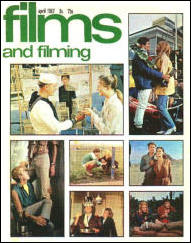THE SAND PEBBLES
Produced and directed by Robert Wise. Screenplay by Robert Anderson. From the novel by Richard McKenna. Associate Producer / Second Unit Director, Charles Maguire. Prodnction designed by Boris Leven. Director of Photography, Joseph MacDonald. Music, Jerry Goldsmith. Editor, William Reynolds. An Argyle-Solar Productions Picture. Panavision. Colour by De Luxe. Presented by 20th Century - Fox. Cert A. 182 mins, excluding interval.
Holman, STEVE McQUEEN; Frenchy, RICHARD ATTENBOROUGH; Collins, RICHARD CRENNA; Shirley, CANDICE BERGEN; Maily, MARAYAT ANDRIANE; Po-Han, MAKO; Jameson, LARRY GATES: Bordelles, CHARLES ROBINSON; Stawski, SIMON OAKLAND.
At first The Sand Pebbles political heart seems to be somewhere in the right place: in the China of 1926, with foreign gun-boats patrolling the Yangtze, it would be difficult not to have some bias and one would like it to be a reasonable one. But we soon realise that this is one thing (there are lots of others, too) that the film does not have. For we realise, with horror, that we are not supposed to laugh when the stars and stripes are raised: this is for real, and we see that the film, as much as anything, is yet another let's-die-for-Uncle-Sam blood and gore romp. Richard Crenna's ship's captain never gets beyond self-parody and at the end falls into undisguised stereotype.
The film is terribly long (just over three hours) and an awful lot of the action of the first half could have been judiciously edited to a more acceptable length. Instead scenes are simply too long to hold our interest, and there are too many scenes that don't further the action: one, a cruelly sadistic torture scene, was so unnecessary that its inclusion made it seem like a horrible obscenity. We might have had a little more exposition of the Chinese problem, but instead we are presented with an array of characters that are easily categorised into black and white and are endowed with more importance than China herself. The scene, the Yangzte with the gun-boats there to 'show the flag', is set. Engineer Jake Holman joins the crew of the USS San Pablo (the Sand Pebbles) to find that the coolies do all the work and the crew do virtually nothing except parade to impress the natives. Jake, played with laconic ease by Steve McQueen, has no background: when
|
 pressed for details later by Shirley Eckert,a teacher who is unaccountably fascinated by the sailor (although she is unquestionably a nice girl, and don't all nice girls love a sailor?), he can only mumble some corny stuff about a delinquent childhood and his mother — 'I guess no one payed much account to ma in those parts, but ... she was a ... a good dame. . . .' The United States, Mother — two great institutions to be revered, and The Sand Pebbles has both. pressed for details later by Shirley Eckert,a teacher who is unaccountably fascinated by the sailor (although she is unquestionably a nice girl, and don't all nice girls love a sailor?), he can only mumble some corny stuff about a delinquent childhood and his mother — 'I guess no one payed much account to ma in those parts, but ... she was a ... a good dame. . . .' The United States, Mother — two great institutions to be revered, and The Sand Pebbles has both.
Jake's little bit about his ma is pretty typical of the script as a whole — mawkish and without any apparent idea of restraint. There is nothing subtle about the film; the characters have absolutely no depth, the relationships have no conviction or meaning. The affair that one of the crew, Frenchy, has with a prostitute (one who hasn't actually been to bed with a man, of course) sums it all up: there is the sentimentality of a whore who is only on the game to pay back a debt, the pure love of the big-hearted sailor, and so on. It's a situation that's a cliche and an extremely unrealistic one at that.
Like so much of The Sand Pebbles, it is just a sequence that might be fine in a book but when in a film is just irrelevant, an unrelated episode. It starts just before the interval and ends just after it. Frenchy and the prostitute disappear from the plot without having affected the film or the hero, who both carry on as if it didn't happen except for the exit of two of the leading players.
DAVID ADAMS |